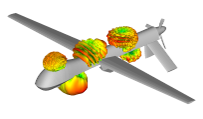With the rapid increase in devices that rely on wireless communication and data transfer, RF engineers face challenges far beyond analyzing the performance of a single antenna. Modern devices often incorporate multiple antennas, each operating within specific frequency bands. This complicates the RF engineer’s role, expanding their task from understanding the behavior of a single antenna to managing the interactions of multiple antennas on the same platform. The coupling effects between these antennas must be considered, particularly when RF engineers are integrating third-party antenna designs rather than creating them from scratch.
What advantages does Ansys HFSS offer for multi-antenna and large problem space design?
Ansys HFSS is a powerful tool that provides several advantages in tackling the challenges associated with multi-antenna systems. It features a robust parametric antenna design toolkit and a comprehensive component library. This allows antenna designers to either start from a unique design or use an approximate model for system integration and placement studies. Moreover, HFSS’s ability to create “Encrypted 3D Components” enables designers to incorporate high-fidelity models from third-party suppliers into platform simulations without revealing proprietary design information, ensuring accurate RF simulations.

How does HFSS handle the complexities of electrically large problem spaces?
One of the standout features of Ansys HFSS is its hybrid solve technology, which combines finite element (FEM), method of moments (MoM), and shooting and bouncing ray (SBR+) solution domains within a single simulation. This technology is particularly effective in solving electrically large problem spaces, such as those involving multiple antennas and platform integration. By leveraging this technology, RF engineers can efficiently simulate complex scenarios where multiple antennas interact with the placement platform, leading to more accurate and efficient design processes.
How do RF engineers mitigate crosstalk and spurious emissions in multi-antenna systems?
In multi-antenna systems, RF engineers must address issues like crosstalk and spurious emissions, which can occur due to the proximity of antennas on the same platform. Solutions may include optimizing antenna placement, applying tuned filters, adjusting radio channels, or modifying antenna architecture. Ansys HFSS allows engineers to calculate coupling coefficients between antennas with the platform in place, accurately accounting for the constructive and destructive field effects caused by the platform’s presence. These calculations are crucial for optimizing the overall system performance.
What role does Ansys EMIT play in optimizing multi-antenna systems?
Ansys EMIT is a powerful antenna system simulation tool that utilizes the coupling coefficients calculated by HFSS to predict the performance of multi-antenna systems. EMIT’s radio model library, along with feedline components such as filters, can be employed to optimize system performance and address Co-site Interference issues. By conducting these optimizations in a virtual environment, RF engineers can refine their designs before moving on to physical prototyping, saving time and reducing costs.
How do HFSS and EMIT contribute to cost-effective RF system design?
Webinar 2: How Do You Simulate Multi-Antenna Systems and Large Problem Spaces with Ansys HFSS?
Webinar 3: How Can You Optimize Ansys HFSS Performance with High-Performance Computing (HPC)?

